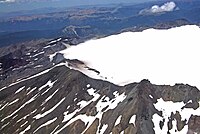
Photo from wikipedia
Abstract The link between carbon dioxide diffuse degassing and its structural control was examined in the Caviahue – Copahue Volcanic Complex, over an area of approximately 10 km2 that encompasses five… Click to show full abstract
Abstract The link between carbon dioxide diffuse degassing and its structural control was examined in the Caviahue – Copahue Volcanic Complex, over an area of approximately 10 km2 that encompasses five hydrothermal sites, namely, Anfiteatro, Copahue town, Las Maquinitas I, Las Maquinitas II and Las Maquinas. Both geochemical and structural approaches were applied in order to investigate the structural scenario releasing hydrothermal fluids in this area. Also, the first isotopic analysis of soil CO2 degassing in the Andean region is presented. The geochemical analysis shows well-defined CO2 diffuse degassing structures in Copahue town, Las Maquinitas I, Las Maquinitas II and Las Maquinas hydrothermal sites. Soil diffuse CO2 is fed by multiple sources: a deep, magmatic – hydrothermal, source, a biogenic source and a mixed source. The structural analysis indicates the presence of an extensional regime that gives place to three structural trends, consisting of NE-SW trending normal faults, NW-SE sinistral strike-slip faults and ENE-WSW right lateral strike-slip faults. The comparison between diffuse degassing structures directions and faults directions suggests that there is a structural control on diffuse degassing. Diffuse CO2 is released through an early extensional setting, and it is emitted through normal faults, strike-slip faults and through areas with higher structural damage, such as relay areas between fault segments and terminations of individual fault segments.
Journal Title: Journal of Volcanology and Geothermal Research
Year Published: 2019
Link to full text (if available)
Share on Social Media: Sign Up to like & get
recommendations!